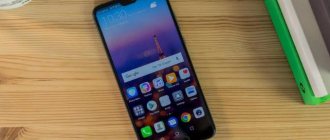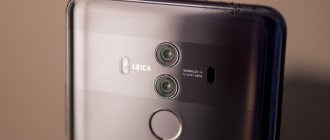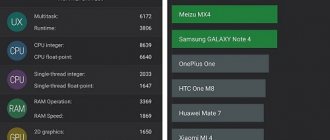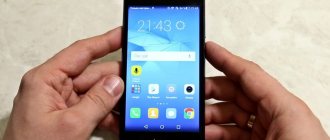Huawei has recently been a leader in the mobile device market in terms of originality and new technologies, and therefore the release of the P20 Pro was anticipated by geeks around the world. Three lenses in the main camera - this has never happened before, and one of them has an incredible resolution - a fantastic 40 MP. What other goodies has the Chinese manufacturer prepared for us, which has seriously taken up the redistribution of the clearing in the premium price segment - read in our review today.
Huawei P20 Pro
Price and main characteristics
The gadget will go on general sale only on April 14, but the price has already been announced - the smartphone will cost 54,990 rubles, which, of course, is not little, but much cheaper than the flagship iPhone or the latest Galaxy S9+.
Specifications:
• Screen: 6.1”, 2240×1080, 407 ppi, automatic brightness adjustment, OLED; • Processor: HiSilicon Kirin 970, 8 cores (4xCortex-A73 2.36 GHz + 4xCortex-A53 1.8 GHz), + i7 coprocessor + Mali-G72 MP12 graphics accelerator; • RAM: 6GB; • internal memory: 128 GB; • camera: three main cameras 40+20+8 MP + front 24 MP; • communications: 4G LTE cat.18, Bluetooth 5.0, NFC, Wi-Fi 802.11 a/b/g/n/ac (2.4/5GHz), GPS, GLONAS; • battery: 4000 mAh, fast charging; • dimensions: 149.1 x 70.8 x 7.65 mm; • weight: 165 grams.
P20 performance and sound
The bottom edge is occupied by two symmetrical holes, but there is only one speaker in the design and fortunately it is located on the right, so it is not blocked by your hand when you play or watch a movie. The sound is high-quality and clear, but there is no reserve in terms of volume. Headphones can only be connected via an adapter or directly to the USB-C port; at least the corresponding headset is included in the package. But in practice this is not always convenient, because if the phone is connected to charging, the connector is occupied and you can only use a wireless headset.
The screen is a pleasure to watch full-length videos and images; the 18.9:7 aspect ratio is a huge advantage. The Kirin 970 processor is slightly inferior in performance to the flagship Snapdragon, but it copes with most games with a bang. The chip contains 4 cores of 1.8 GHz, which are used when operating the shell and when solving simple tasks. For games, there are 4 high-performance cores up to 2.36 GHz, which allow you to enjoy the gaming process. Huawei P20 technical specifications suggest the presence of 128 GB of internal memory, which is enough for even the most demanding users, and 4 GB of RAM is the optimal amount for today. If you need more, then you should pay attention to the Pro version, which received 6 GB of RAM. The performance is enough for even the most demanding games, but the solutions on the flagship Snapdragon P20 are still inferior. The situation should change in the brand's future flagships, which will be the first in the world to receive a processor designed using the 7-NM process technology.
There is no MicroSD slot; it’s not for nothing that the manufacturer offered such a generous amount of built-in storage.
Equipment and appearance
Huawei P20 Pro is made of glass and metal, which is a kind of trend today. The “island” on the front panel immediately catches your eye - Apple products could not help but influence the design of the Chinese, and therefore placing the front camera and lens on this recess is unlikely to convince anyone that it was added for a utilitarian purpose. The smartphone is available in three colors – black, blue and twilight.
The ergonomics of the firmware are almost identical to the base P20, the difference lies in the presence of a third main camera, but it found its place exactly under the first two, so there are no unexpected experiments. We won’t describe the location of the power buttons and the SIM card slot - everything is standard, but we note that the gadget has IP67 protection, so those who like to drop their smartphones in the bathroom will be safe.
Screen
The display has grown slightly compared to the P20, its diagonal is 6.1 instead of 5.8 inches. The OLED matrix shows amazing results; the picture looks very good at a resolution of 2240x1080 pixels. It is clear that flagships have not allowed misfires in such aspects as viewing angles or, for example, brightness range for a long time, but I still want to praise the engineers from Huawei - the image is incredibly rich and perfectly readable in the bright sun, and at minimum settings you can read in the dark no harm to eyes.
In principle, the screen is not something unique - we saw more resolution, and the diagonal, and the frames here are quite familiar today. But all together it really makes a very pleasant impression and you don’t want to part with the device; the colors in the surrounding April reality are still noticeably inferior to digital ones.
Display
Huawei P20 is equipped with a 5.8-inch IPS screen with FullHD+ resolution (2244×1080 pixels) and an aspect ratio of 18.7:9. And although the Chinese saved the OLED display for the more expensive P20 Pro, there are no complaints about the screen of the regular twenty.
The display occupies 80.4% of the front panel area. The 5.8-inch diagonal is a good compromise between the standard size and phablets, and thanks to the elongation and thin side frames, the smartphone can be easily controlled by holding it in one hand.
The P20 has a variety of screen customization options: you can enable Natural Color mode, which adjusts the display's color temperature to suit the environment, switch between normal and rich colors, activate eye protection mode, reduce resolution to save battery power, and much more.
But there is no particular need to do this, even with the default settings the screen looks great - maximum viewing angles, clear and bright colors, icons literally jump off the screen. Now this is one of the best IPS matrices on the market.
Now about the unibrow. It is the least annoying here among all the imitators of the tenth iPhone - the cutout for the front camera and the earpiece are much smaller than those of competitors, in addition, there is the ability to turn on a black fill on both sides of the island, thereby obtaining a uniform upper edge of the display (the time can be displayed on a black background and notifications).
Performance
Huawei prefers to equip its smartphones with chipsets of its own production, which often causes skepticism among Qualcomm adherents, but the HiSilicon Kirin 970 is still a flagship piece of hardware, and therefore all the standard complaints about the processors of this manufacturer are inappropriate. Owners of Huawei Mate 10 Pro are already familiar with this eight-core monster, designed to work with artificial intelligence, and were satisfied, and the P20 Pro also uses the ultra-modern video GPU Mali G72, which will last for several years.
The RAM here is standard for flagships - 6 GB, and the internal memory is 128, and the use of memory cards is not provided. To be honest, this is a rather strange decision; there are many consumers interested in the maximum amount of memory, so it would be reasonable to release at least a 256 GB version, but so far there are not even rumors about such an option. We can talk about actual performance after the release, that is, in a week, but it is already clear that the gadget will go to the very top based on its performance in any benchmarks.
Specifications
| Size: | 149.1×70.8×7.65 mm; |
| Weight: | 165; |
| Capacity: | 4 GB RAM, 128 GB internal; |
| Display: | 5.84 inches, 2240×1080, 425 ppi, LTPS IPS; |
| CPU: | Chipset HiSilicon Kirin 970, 8 cores (4xCortex-A73 2.36 GHz + 4xCortex-A53 1.8 GHz) + i7 coprocessor and Mali-G72 MP12 graphics accelerator; |
| Camera: | 12 megapixels (color)/20 MP (b/w) megapixels, f/1.6/1.8, OIS, LED flash, 4K video recording; |
| Sim: | nanoSIM, up to two cards; |
| Battery: | Li-Pol 3400 mA, fast charging; |
| Operating system: | Android 8.1, EMUI 8.1; |
Camera
Of course, the main purpose of the device will be photo and video shooting. Three main cameras - this has never happened before in mass production, although renders of the Galaxy S9/S9+ with three lenses depicted on them are already beginning to appear.
The most powerful sensor has a resolution of 40 megapixels and an f/1.8 lens aperture, which allows it to produce images of incredible quality and detail. The second module is monochrome 20 megapixels and f/1.6 aperture, which expands the dynamic range and helps convey midtones. The third provides digital zoom, but it is wise to use it only in excellent daylight, otherwise the footage will come out very average for such technology. The smartphone has a choice of ISO values in the range from 100 to 51,200, while even top gadgets have an upper limit of around 6400. We can talk about the results after the commercial sample goes on sale, but in any case it will be a bomb. The front camera has a lot of features related to the work of artificial intelligence, so those who like to change real lighting to the desired one and create 3D models of their own heads should already be preparing to run to the store on April 14.
P20 Camera Review
The smartphone uses a dual Leica main camera of 12 megapixels with f/1.8 aperture and 20 megapixels with f/1.6 aperture. Such a combination should perform excellently, especially when shooting at night. And Leica sensors have proven themselves very well in Huawei smartphones. The front camera is represented by a 24 megapixel module with f/2.0 aperture. There is image stabilization, and in addition to this, artificial intelligence helps, processing the image and setting the ideal parameters for the current shooting conditions. A review of the P20 camera showed that, unlike the Pro version, it uses a double rather than a triple module, which somewhat limits the capabilities, but the quality of the images is still excellent.
Artificial intelligence automatically sets the shooting mode. For example, if there is a cat in front of the lens, it automatically switches to the appropriate parameters so that as a result you can get the perfect shot. When testing the Huawei P20, the function behaved as expected if a cat or dog was in the lens, but when a parrot was in front of the lens, the algorithms got confused and mistook it for a cat.
Among the disadvantages that the Huawei P20 review showed is the inconvenient interface of the camera application, which has a very awkward structure, and some functions can only be accessed through the settings menu.
To access shooting modes, you need to swipe left or right, and to access the full list, you need to tap “more.” In addition, not all modes are activated manually; some of them are available exclusively in automatic mode and are launched by artificial intelligence if it deems them necessary at the moment. Photos are taken instantly, so with the P20 you won't miss anything important.
The Super Night mode deserves special mention, which is based on artificial intelligence and helps you get a good shot at night. The mode has been used in the brand's devices for a long time, but in the P20 it has been greatly improved. At night, a high exposure and special settings are set to get a high-quality and blur-free photo. This is the main advantage of a smartphone, because even most flagships cannot take pictures at night. The function does not always work perfectly and will obviously be improved in future updates, but right now it significantly increases the likelihood of getting a good photo.
When shooting in automatic mode, we get rich and detailed photos. Whether indoors or outdoors, the photos turn out great. The result is comparable to the top flagships of 2017-2018. The difference with competitors is especially noticeable when shooting at night, where the P20 is far ahead. The grain in the photo is even less than in the case of the Pixel XL2 camera. Only the Samsung Galaxy S9 can compare with it.
2x hybrid zoom turns on automatically when you take a close-up shot. As a result, it is possible to capture an enlarged subject without loss of quality.
When a person is in front of the lens, portrait mode is automatically set. The result is a spectacular shot with background blur, which is done very carefully without affecting the subject. Artificial intelligence helps a lot here.
Speaker, sound quality
The device is equipped with two stereo speakers that sound very clear and loud. Dolby Atmos technology is available, and a complex artificial intelligence algorithm is responsible for noise reduction, so there will be no problems with conveying information to the interlocutor.
Not much is known about the musical component of the gadget; the company spends a lot of effort to convey to the public all the advantages of the camera and the work of neural networks, but we can safely assume that with a high-quality headset and with a little witchcraft in the settings, you can certainly get excellent and rich sound. But we’ll learn about all the audiophile things like clarity of highs and thick bass a little later.
Battery
Taking into account the energy-efficient processor of its own production, Kirin 970, and the OLED matrix, one could imagine that the Chinese would not bother with the battery at all, they say, it will do. But it didn’t turn out that way, 4000 mAh is an excellent indicator for such a system, so the device can easily work for 1.5 - 2 days in active use mode, and if you want to spend the whole day off watching your favorite TV series, then you don’t have to look for charging - gadget with video and 20 hours of video in a row.
The situation with games is more complicated; unfortunately, some masterpieces of the gaming industry are not well optimized and consume battery power at unprecedented speeds, but you can still count on 6-7 hours of battery life. And this is practically the top figure on the market, if you don’t take into account gadgets with incredible 10,000 mAh batteries, which, by the way, don’t even hold up to top-end toys.











